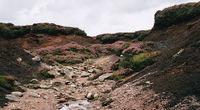Peat: Difference between revisions
imported>Martin Wyatt (Created page with "{{subpages}} '''Peat''' is partially decomposed plant material, the plants usually being grasses or mosses. It requires the presence of water to prevent oxidation or bacteria...") |
imported>Pat Palmer (adding subpages) |
||
| (2 intermediate revisions by one other user not shown) | |||
| Line 1: | Line 1: | ||
{{subpages}} | {{subpages}} | ||
'''Peat''' is partially decomposed plant material, the plants usually being grasses or mosses. It requires the presence of water to prevent oxidation or bacterial destruction. It is normally dark brown in colour. Where prevalent, it establishes a particular environment for lime-intolerant plants and some forms of animal life. | '''Peat''' is partially decomposed plant material, the plants usually being grasses or mosses. It requires the presence of water to prevent oxidation or bacterial destruction. It is normally dark brown in colour. Where prevalent, it establishes a particular environment for lime-intolerant plants and some forms of animal life. {{Image|Peak peat.jpg|right|200px|Add image caption here.}} | ||
Peat is inflammable when dried out and has been much used as a household fuel. It is not as dense as [[coal]]. A slab of peat used for fuel is known as "a peat". Its extraction has been a considerable industry in certain areas, with its own tools and terminology. | Peat is inflammable when dried out and has been much used as a household fuel. It is not as dense as [[coal]]. A slab of peat used for fuel is known as "a peat". Its extraction has been a considerable industry in certain areas, with its own tools and terminology. | ||
The peat extraction industry continues, particularly in providing peat as a basis for garden "compost". This use exploits its potential as a soil conditioner to which other ingredients may be added. As peat takes a very long time to develop, the industry has been criticised for large-scale destruction of a certain type of habitat. | The peat extraction industry continues, particularly in providing peat as a basis for garden "compost". This use exploits its potential as a soil conditioner to which other ingredients may be added. As peat takes a very long time to develop, the industry has been criticised for large-scale destruction of a certain type of habitat. | ||
Latest revision as of 07:12, 8 September 2020
Peat is partially decomposed plant material, the plants usually being grasses or mosses. It requires the presence of water to prevent oxidation or bacterial destruction. It is normally dark brown in colour. Where prevalent, it establishes a particular environment for lime-intolerant plants and some forms of animal life.
Peat is inflammable when dried out and has been much used as a household fuel. It is not as dense as coal. A slab of peat used for fuel is known as "a peat". Its extraction has been a considerable industry in certain areas, with its own tools and terminology.
The peat extraction industry continues, particularly in providing peat as a basis for garden "compost". This use exploits its potential as a soil conditioner to which other ingredients may be added. As peat takes a very long time to develop, the industry has been criticised for large-scale destruction of a certain type of habitat.
